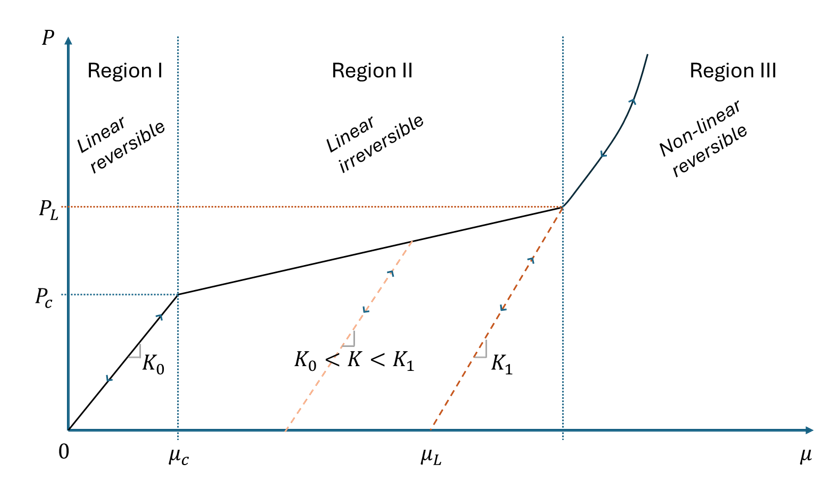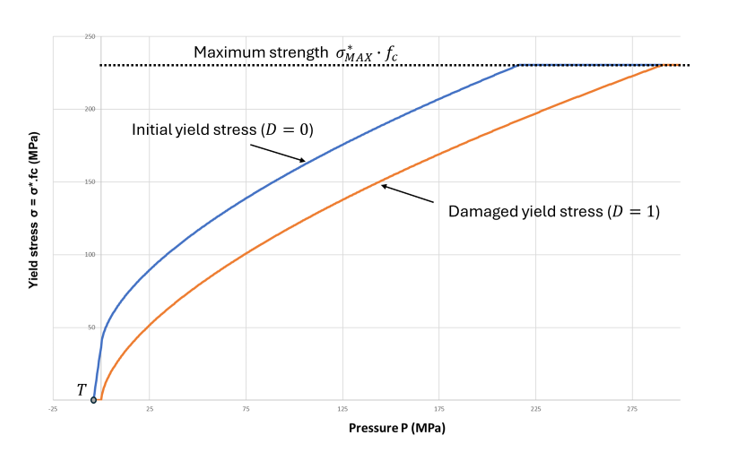/MAT/LAW126 (JOHNSON_HOLMQUIST_CONCRETE)
Block Format Keyword This material law describes the behavior of brittle materials, more specifically dedicated to concrete.
Format
| (1) | (2) | (3) | (4) | (5) | (6) | (7) | (8) | (9) | (10) |
|---|---|---|---|---|---|---|---|---|---|
| /MAT/LAW126/mat_ID/unit_ID or /MAT/JOHNSON_HOLMQUIST_CONCRETE/mat_ID/unit_ID | |||||||||
| mat_title | |||||||||
| G | |||||||||
| a | b | n | T | ||||||
| c | FCUT | ||||||||
| PC | PL | ||||||||
| K1 | K2 | K3 | |||||||
| D1 | D2 | IDEL | IFAILSO | ||||||
Definition
| Field | Contents | SI Unit Example |
|---|---|---|
| mat_ID | Material identifier. (Integer, maximum 10 digits) |
|
| unit_ID | (Optional) Unit identifier. (Integer, maximum 10 digits) |
|
| mat_title | Material title. (Character, maximum 100 characters) |
|
| Initial
density. (Real) |
||
| G | Shear modulus. (Real) |
|
| A | Normalized cohesive
strength. (Real) |
|
| B | Normalized pressure hardening
modulus. (Real) |
|
| N | Pressure hardening
exponent. (Real) |
|
| Quasi-static uniaxial compressive
strength. (Real) |
||
| T | Maximum hydrostatic tensile
pressure. (Real) |
|
| C | Strain rate coefficient.
(Real) |
|
| Reference strain rate. Default = 1.0 (Real) |
||
| FCUT | Cutoff frequency for strain rate filtering.
(Real) |
|
| Maximum normalized
strength. Default = 1020 (Real) |
||
| Minimum fracture strain. Default = 10-20 (Real) |
||
| PC | Crushing
pressure. (Real) |
|
| Crushing volumetric
strain. (Real) |
||
| PL | Locking
pressure. (Real) |
|
| Locking plastic volumetric
strain. (Real) |
||
| K1 | Linear bulk
stiffness. (Real) |
|
| K2 | Quadratic bulk
stiffness. (Real) |
|
| K3 | Cubic bulk
stiffness. (Real) |
|
| D1 | Damage
parameter. (Real) |
|
| D2 | Damage
exponent. (Real) |
|
| IDEL | Element failure criteria flag:
(Integer) |
|
| Critical plastic strain for element
deletion. Default = 1020 (Real) |
||
| IFAILSO | Element post-failure behavior flag (if
IDEL > 0).
(Integer) |
Example
#RADIOSS STARTER
#---1----|----2----|----3----|----4----|----5----|----6----|----7----|----8----|----9----|---10----|
/UNIT/1
Unit for material
Mg mm s
#---1----|----2----|----3----|----4----|----5----|----6----|----7----|----8----|----9----|---10----|
/MAT/LAW126/1/1
Concrete
# Init. dens.
2.440E-9
# G
14860
# A B N FC T
0.79 1.60 0.61 48 4
# C EPS0 FCUT SFMAX EFMIN
0.007 1.0 10000 7 0.01
# PC MUC PL MUL
16 0.001 800 0.1
# K1 K2 K3
85000 -171000 208000
# D1 D2 IDEL EPS_MAX IFAILSO
0.04 1.0 3 0 1
#---1----|----2----|----3----|----4----|----5----|----6----|----7----|----8----|----9----|---10----|
#ENDDATA
/END
#---1----|----2----|----3----|----4----|----5----|----6----|----7----|----8----|----9----|---10----|Comments
- This material law is based on the theory of Johnson-Holmquist-Cook model theory (also called Johnson-Holmquist-Concrete). It was proposed and designed for a concrete application. In this model, the spherical and deviatoric behavior are separated. It considers the effect of damage and strain rate sensitivity.
- The spherical behavior is described with a constitutive equation
based on hydrostatic pressure (considered positive in compression). This
behavior is divided into 3 regions (Figure 1) in the evolution hydrostatic pressure versus
volumetric strain denoted
.In the first region, the pressure response is supposed linear and elastic. In the second region, the microcavities of the material are supposed to be crushed, generating a plastic volumetric strain denoted , modifying linearly the bulk modulus from and . When all the cavities have been crushed and the material becomes fully dense. Then, the pressure evolution follows a polynomial equation of state.
Figure 1. Hydrostatic pressure variation with respect to volumetric strain 
- The deviatoric behavior is defined with an elasto-plastic behavior,
where the normalized yield stress is both a yielding and a damaging limit.
Its expression is:
- If
(compressive
loadings):
Where, bounded by .
- If
(tensile loadings):To get the yield stress, the normalized value is multiplied by . These two yield stresses shapes (for compressive and tension loadings) are plotted for a damage value of 0 (initial material) and 1 (fully fractured material) in Figure 2:
Figure 2. Yield stress evolution with respect to hydrostatic pressure 
To trigger the deviatoric elasto-plastic behavior, the normalized yield stress is compared to the current normalized equivalent von Mises stress:
This allows to compute the evolution of the deviatoric plastic strain denoted .
- If
(compressive
loadings):
- The damage variable evolution is dependent to both volumetric and
deviatoric plastic strain. Its expression is given by:
Where, the effective strain at failure is defined by:
- Time history and animation output is available using these USRi variables.
- USR1: Plastic volumetric strain
- USR2: Bulking pressure
- USR3: Volumetric strain
- USR4: Yield stress
- Strain rate filtering can be used and activated when a cutoff frequency FCUT for filtering is defined.
- The damage variable can be plotted in ANIM and H3D file using the output option DAMG.
- To avoid damage mesh dependency, due to mesh size or orientation,
the non-local regularization method can be used
(/NONLOCAL/MAT). In this case, the sum of the
deviatoric plastic strain
and volumetric plastic strain
is regularized and used for damage
evolution:
The regularized sum can be plotted using /ANIM/ELEM/NL_EPSP or /H3D/ELEM/NL_EPSP.